Οι περισσότερες δημοφιλείς εφαρμογές έχουν μια ασφαλή λειτουργία που επιτρέπει στους χρήστες να εκτελούν το πρόγραμμα με περιορισμένη λειτουργικότητα όταν τα πράγματα δεν εκτελούνται όπως θα έπρεπε. Αυτό συμβαίνει με το Outlook - έναν σύνθετο διαχειριστή email που χρησιμοποιεί την ασφαλή λειτουργία για να παρακάμψει πολλά ζητήματα που το εμποδίζουν να ξεκινήσει. Μπορεί να εκκινήσετε σκόπιμα το Outlook σε ασφαλή λειτουργία, αλλά μπορεί επίσης να ξεκινήσει από μόνη της σε αυτήν τη λειτουργία.

Εκτός αν ξεκινήσατε μόνοι σας την Ασφαλή λειτουργία για οποιονδήποτε λόγο, δεν θα σας συμβουλεύσω να συνεχίσετε να χρησιμοποιείτε το Outlook σε αυτήν τη λειτουργία. Δεν θα μπορείτε να αποθηκεύσετε πρότυπα, προτιμήσεις και, μεταξύ άλλων, δεν θα μπορείτε να χρησιμοποιείτε έξυπνες ετικέτες. Εάν βρίσκεστε σε τέτοιου είδους καταστάσεις, συνιστάται να αντιμετωπίζετε την Ασφαλή λειτουργία ως διαγνωστικό εργαλείο και να επιλύετε το πρόβλημά σας.
Πότε χρησιμοποιείται η ασφαλής λειτουργία στο OutLook
Το Outlook ενημερώνει τακτικά το μητρώο συστήματος για να επιτρέπει στις νέες επεκτάσεις που εγκαθιστάτε να λειτουργούν όπως θα έπρεπε. Εάν το πρόγραμμα εντοπίσει ένα πρόβλημα κατά την εκκίνηση που το εμποδίζει να εκτελεστεί, θα μετατραπεί αυτόματα σε ασφαλή λειτουργία . Αυτό συμβαίνει συνήθως αμέσως μετά την εγκατάσταση ενός νέου πρόσθετου που δεν παίζει καλά με την έκδοση του Outlook.
Μπορείτε να ενεργοποιήσετε μόνοι σας την ασφαλή λειτουργία ανοίγοντας ένα παράθυρο Εκτέλεσης και πληκτρολογώντας το Outlook / safe και πατώντας OK .

Σε περίπτωση που το Outlook ξεκινά αυτόματα σε ασφαλή λειτουργία , είναι συνήθως ένα σημάδι ότι κάτι δεν λειτουργεί σωστά. Μερικές φορές, το Outlook θα καταφέρει να εντοπίσει το πρόσθετο στοιχείο που εμποδίζει το Outlook να ξεκινήσει κανονικά. Εάν σας ζητήσει να απενεργοποιήσετε το ελαττωματικό στοιχείο, δοκιμάστε το και δείτε εάν το Outlook καταφέρνει να ξεκινήσει κανονικά.

Πιθανές ενεργοποιήσεις ασφαλούς λειτουργίας
Εάν χρησιμοποιείτε την έκδοση 2010, το πρόβλημά σας πιθανότατα οφείλεται στην ενημέρωση KB3114409 που προκαλεί την εκκίνηση του Outlook σε ασφαλή λειτουργία και την επαναφορά στις προεπιλεγμένες ρυθμίσεις. Σε περίπτωση που χρησιμοποιείτε παλαιότερη έκδοση του Outlook, όπως το 2007 ή το 2003, το πρόβλημά σας ενδέχεται να σχετίζεται με την υπηρεσία αναζήτησης των Windows . Το λάθος πρόσθετο μπορεί επίσης να έρχεται σε διένεξη με την έκδοση του Outlook σε σημείο που θα το αναγκάσετε να ξεκινήσει σε ασφαλή λειτουργία .
Αυτοί είναι μόνο τρεις από τους πιθανούς ενόχους, αλλά οι αιτίες μπορεί να προέρχονται από πολλά μέρη.
Παρακάτω έχετε μια συλλογή από διορθώσεις που έχουν ήδη βοηθήσει πολλούς χρήστες να εμποδίσουν την εκτέλεση του Outlook σε ασφαλή λειτουργία . Ακολουθήστε τις παραπάνω μεθόδους, σύμφωνα με την έκδοση του Outlook, έως ότου βρείτε μια επιδιόρθωση που λύνει το πρόβλημά σας.
Μέθοδος 1: Απενεργοποίηση πρόσθετων σε ασφαλή λειτουργία (Όλες οι εκδόσεις του Outlook)
Αυτό είναι ένα συνηθισμένο φαινόμενο σε κάθε έκδοση του Outlook από το Outlook 2007 έως το Outlook 2016 . Αυτό συμβαίνει επειδή ορισμένα πρόσθετα θα έρχονται σε διένεξη με την έκδοση του Outlook. Αυτό είναι ακόμη πιο πιθανό με παρωχημένα πρόσθετα εγκατεστημένα στις πιο πρόσφατες εκδόσεις του Outlook.
Σημείωση: Εάν εγκαταστήσατε το πρόσθετο ABBYY FineReader πριν ξεκινήσει αυτό το σφάλμα, ακολουθήστε τα παρακάτω βήματα για να καταργήσετε το πρόσθετο από την έκδοση του Outlook.
- Επιβεβαιώστε ότι το Outlook βρίσκεται σε ασφαλή λειτουργία ελέγχοντας για να δείτε εάν το εικονίδιο στη γραμμή εργασιών σας έχει θαυμαστικό.

Σημείωση: Μπορείτε επίσης να επιβεβαιώσετε κοιτάζοντας βλέποντας εάν εντοπίζετε (Ασφαλής λειτουργία) στην επάνω ενότητα της οθόνης.

- Τώρα, αναπτύξτε την καρτέλα Αρχείο και κάντε κλικ στο Επιλογές .

- Τώρα κάντε κλικ στην καρτέλα Πρόσθετα . Από εκεί, μεταβείτε στο αναπτυσσόμενο μενού δίπλα στη Διαχείριση και επιλέξτε COM Add-ins από τη λίστα. Κάντε κλικ στο Μετάβαση για να συνεχίσετε.
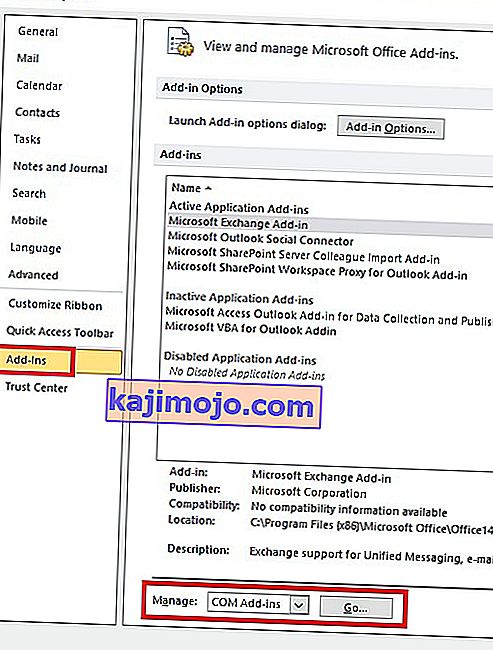
- Σε αυτό το σημείο, θα πρέπει να τραβήξετε ένα στιγμιότυπο οθόνης της λίστας πρόσθετων και να το αποθηκεύσετε κάπου βολικό. Αυτό θα σας βοηθήσει να επαναφέρετε την κανονική διαμόρφωση του Outlook σας εάν προκύψουν δυσλειτουργίες μετά την απενεργοποίηση των πρόσθετων.
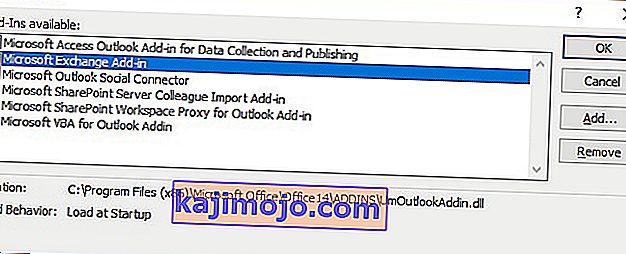
- Απενεργοποιήστε κάθε καταχώριση (διαγραφή επιλεγμένων πλαισίων ελέγχου) και πατήστε OK .
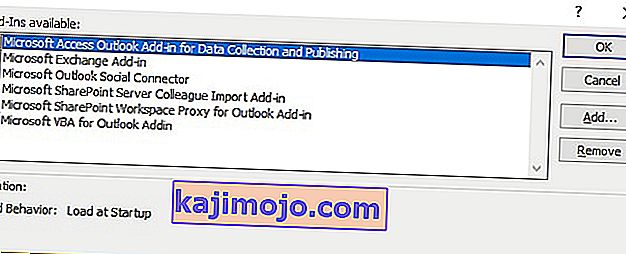 Σημείωση: Μην πατήσετε Αφαίρεση ακόμα. Πρώτα πρέπει να επιβεβαιώσουμε ότι προκαλούν το πρόβλημα.
Σημείωση: Μην πατήσετε Αφαίρεση ακόμα. Πρώτα πρέπει να επιβεβαιώσουμε ότι προκαλούν το πρόβλημα. - Κλείστε το Outlook και ανοίξτε το ξανά. Εάν το πρόγραμμα εκκινήσει σε κανονική λειτουργία, το πρόβλημά σας έχει επιλυθεί.
Σημείωση: Σε περίπτωση που εξακολουθεί να ξεκινά σε ασφαλή λειτουργία , μεταβείτε στις Επιλογές αρχείων> Πρόσθετα και ενεργοποιήστε ξανά τα πρόσθετα που απενεργοποιήσαμε στο βήμα 5 και μεταβείτε στη Μέθοδο 2 .
- Επιστρέψτε στο αρχείο> Επιλογή> Πρόσθετα και ενεργοποιήστε ξανά συστηματικά κάθε πρόσθετο ένα προς ένα έως ότου αποκαλύψετε αυτό που προκαλεί διενέξεις.
- Επιλέξτε το και πατήστε Κατάργηση .
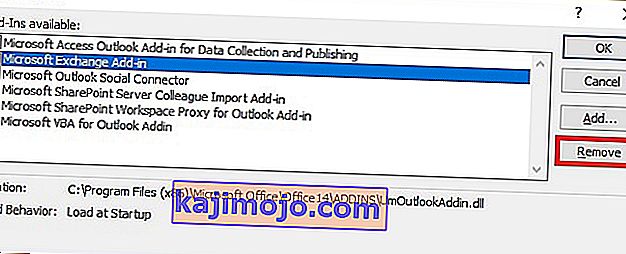
- Επανεκκινήστε το Outlook και δείτε εάν ξεκινά σε κανονική λειτουργία.
Μέθοδος 2: Επαναφέρετε τον υπολογιστή σας χρησιμοποιώντας την Επαναφορά συστήματος (Όλες οι εκδόσεις του Outlook)
Η επαναφορά συστήματος είναι μια δυνατότητα των Windows που επιτρέπει στους χρήστες να επαναφέρουν την κατάσταση του υπολογιστή τους σε μια προηγούμενη χρονική στιγμή. Αυτό εξυπηρετεί το σκοπό μας, εάν μπορούμε να επιστρέψουμε σε κατάσταση που προηγουμένως άρχισε να λειτουργεί δυστυχώς το Outlook. Να τι πρέπει να κάνετε:
- Κρατήστε πατημένο το πλήκτρο Windows και πατήστε R. Πληκτρολογήστε rstrui.exe και κάντε κλικ στο OK .
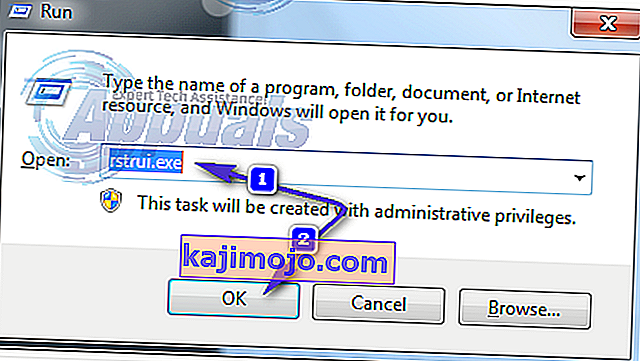
- Στο παράθυρο Επαναφορά συστήματος, επιλέξτε Επιλογή διαφορετικού σημείου επαναφοράς και πατήστε Επόμενο.
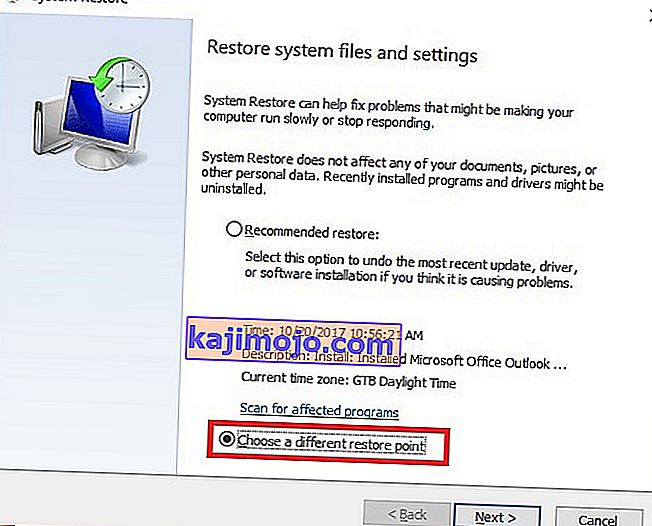
- Παχύ πλαίσιο δίπλα στην επιλογή Εμφάνιση περισσότερων σημείων επαναφοράς.
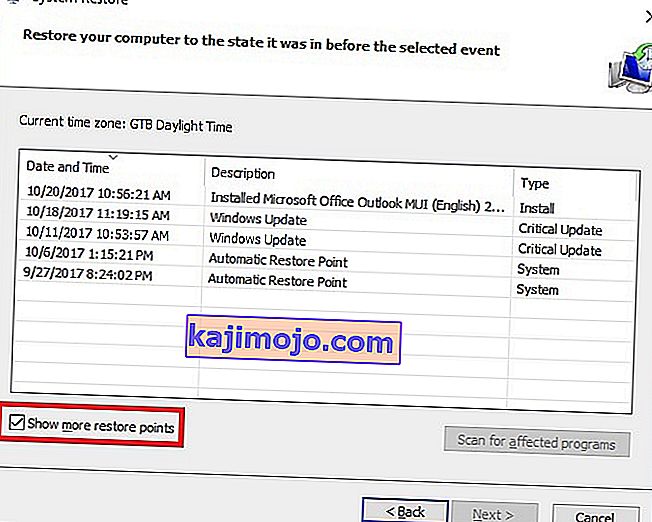
- Εντοπίστε ένα σημείο όταν το Outlook λειτουργούσε και, στη συνέχεια, επιλέξτε αυτό το σημείο επαναφοράς και συνεχίστε με οδηγίες στην οθόνη για να επαναφέρετε τον υπολογιστή σε προγενέστερο χρόνο.
- Once this is done, the system will begin restoring. After the restore has finished, check to see if Outlook works. if it doesn’t, then proceed to Method 3.
Method 3: Restore to a previous version of Outlook
If restoring your desktop OS to an earlier version didn’t work, let’s try restoring Outlook to a previous version. Here’s how:
- Click Start and type Outlook.exe in the search dialog. Right-click on it and choose Properties.
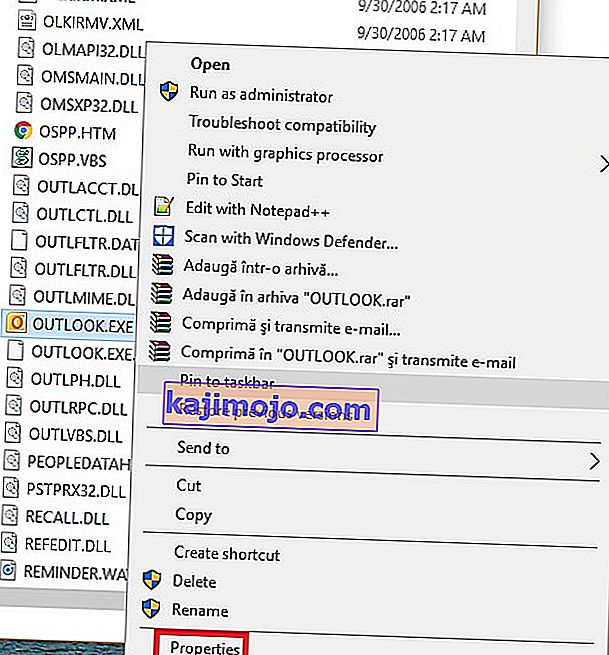
- Then go to the Previous Versions tab, and locate the Outlook.exe file that has a date when it worked. Click Open to see if it works and opens without Safe Mode.
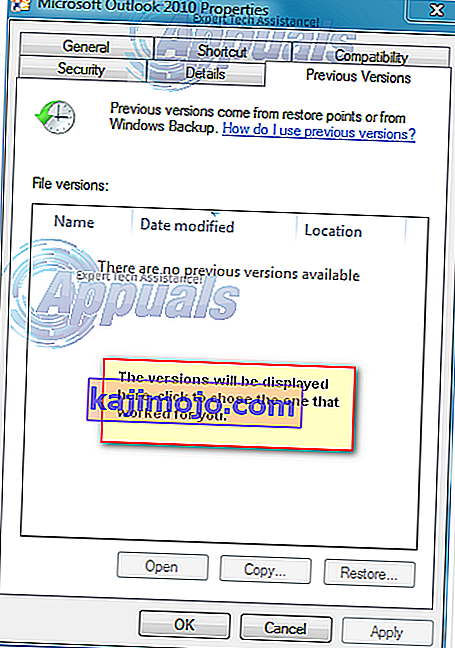 Note: Make sure the non-working Outlook that previously opened in Safe Mode is closed because we are now running one of the copies saved in the previous versions. Do the same for all versions listed there. Open/Close until you see the one that opens without Safe Mode. If it does work, then keep the Window open.
Note: Make sure the non-working Outlook that previously opened in Safe Mode is closed because we are now running one of the copies saved in the previous versions. Do the same for all versions listed there. Open/Close until you see the one that opens without Safe Mode. If it does work, then keep the Window open. - Assuming that you now have the version of Outlook running, without Safe Mode from one of the previous versions. Hold the Windows Key and Press R. Type taskmgr and click OK.
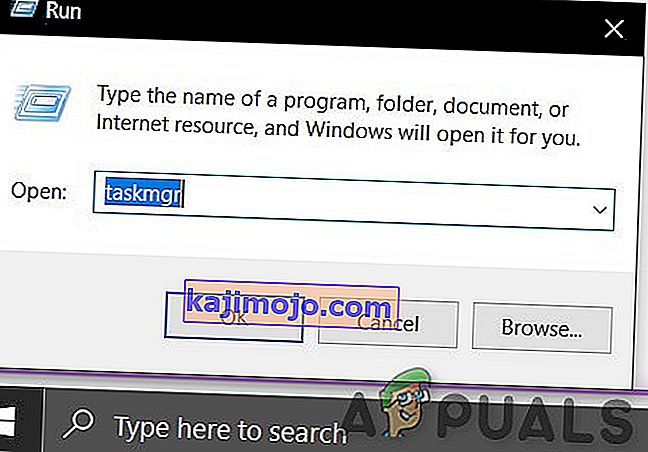
- In the Task Manager Window, Go to the Process Tab, locate Outlook.exe, right-click on it and choose Open File Location.
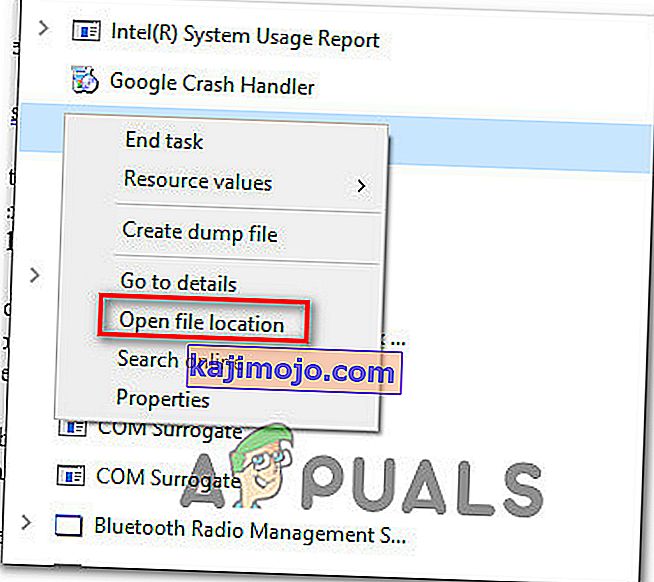
- Copy all the files from the next window, then navigate to C:\Program Files (x86)\Microsoft Office\Office. Paste the filed previously copied here.
- Try to re-open Outlook and see if it starts in normal mode.
Method 4: Uninstalling the KB3114409 update ( Outlook 2010)
Sometime in 2015, Microsoft issued a security patch that caused Outlook to run in Safe Mode and revert it back to the default configuration. The user-made configurations aren’t lost forever and will be back when Outlook manages to boot up in normal mode.
If you have this problem, there are two ways to proceed forward. Since Microsoft issued an update that fixes the problem caused by KB3114409, we can install that over the bad update. A different route would be to simply uninstall the KB3114409.
We highly recommend you to go for installing the official Microsoft update fix. But regardless of which option you opt for, we will guide you through the whole process.
Using the official Microsoft fix
Microsoft update KB3114560 was issued specifically to fix the damage done by KB3114409. As a rule of thumb, you should always install security updates from the official website. Here’s what you need to do:
- Access this official link and click on one of the two different update versions, according to your PC specs.
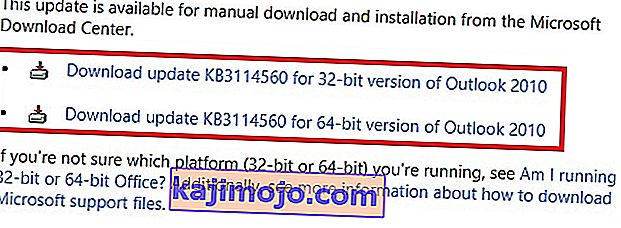
- Select the default language of your Outlook program and click on the Download button.
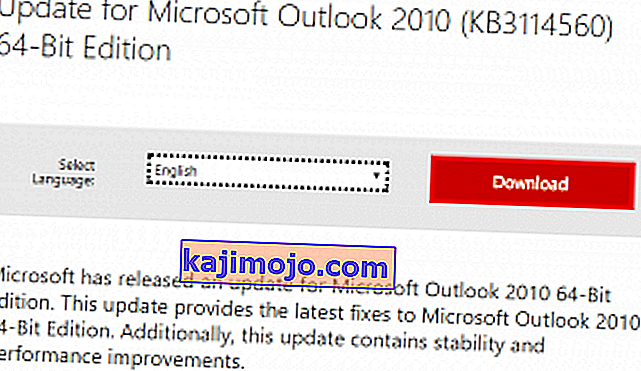
- Once the update has been downloaded, open the executable and follow through with the installation process.
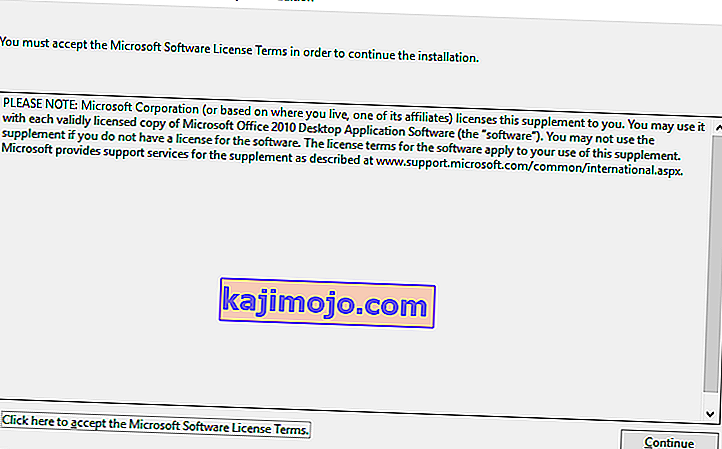
- Restart your PC, open Outlook again and see if the issue has been resolved.
Uninstalling the KB3114409 update
- Close Outlook completely.
- Open Control Panel, click on Uninstall a program.
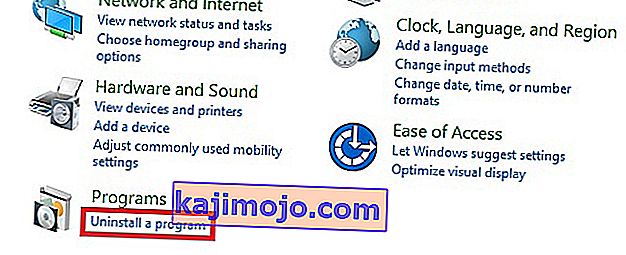
- Once you’re in the Programs and Features window, click on View installed updates.
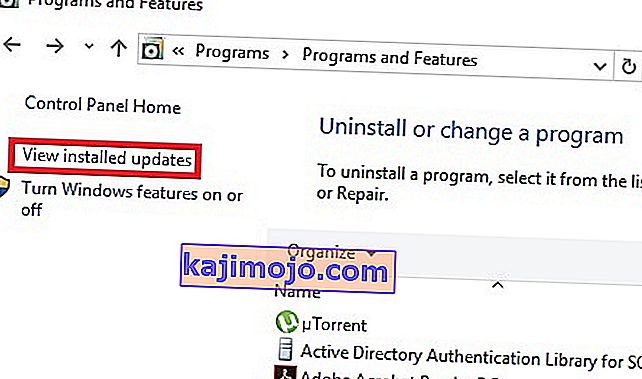
- Use the Search Installed Updates search bar in the top-right corner to search for the bad update (KB3114409 ).

- Once you manage to identify the bad update, click the Uninstall button and follow through with the confirmation prompts.
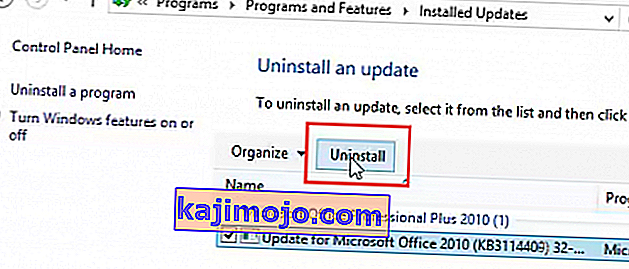
- Restart your PC, open Outlook and see if the issue repeats.
Method 5: Doing an Outlook Profile reset (All Outlook versions)
If you experience hanging at the initial Outlook splash screen (right before it initiates Safe Mode), you might need to do a profile reset. Here’s how to do it:
- Go to Control Panel > Mail and click on Show Profiles.
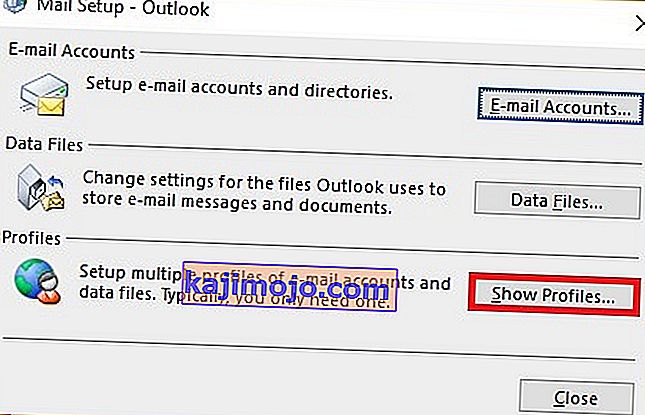
- Now, create a new profile by clicking the Add button. Insert a name and hit OK.
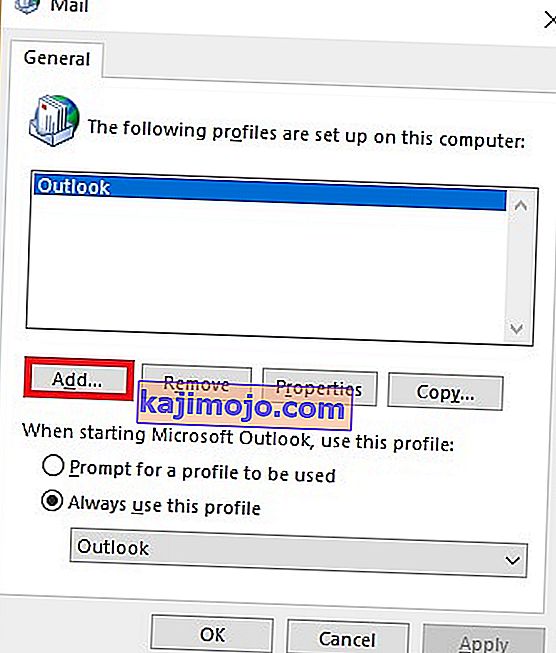
Note: Do not delete the original profile, because we don’t know if this will end up fixing the issue.
- Go through the steps of configuring your email account with Outlook. Make sure to use the same email that you have on the already created profile.
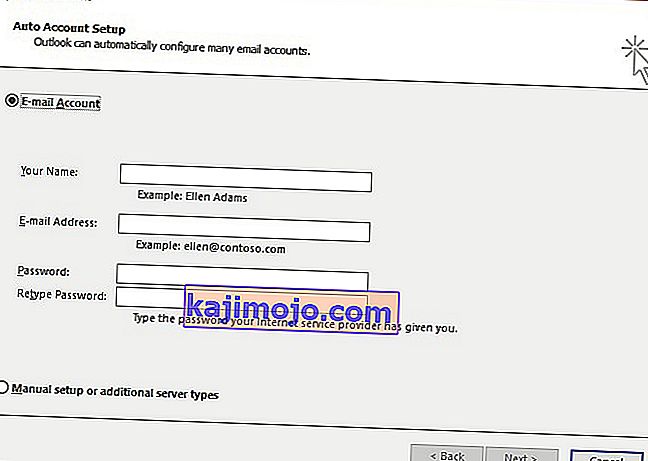
- Now return to the Mail window and make sure the profile you’ve just created is being used by default. Hit Apply to confirm your selection.
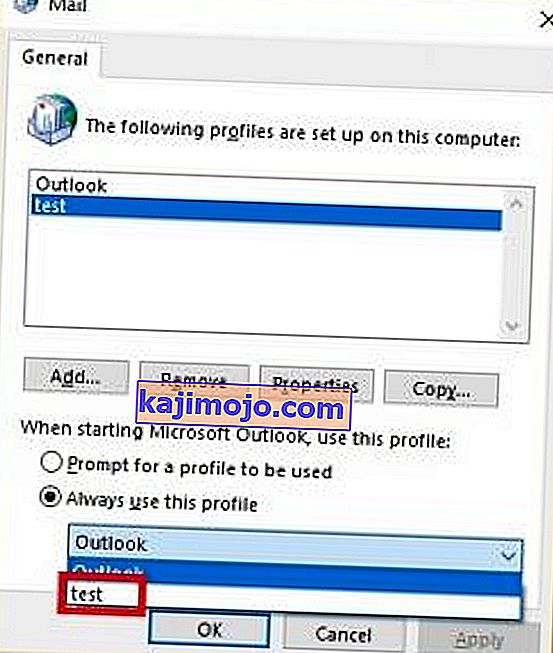
- Start Outlook again and see if it manages to start in normal mode after the profile reset.
Method 6: Checking the PST folder for corruption (All Outlook versions)
Another common cause for Outlook starting in Safe Mode is the Personal Folders File (PST). In the event that it becomes very large, or some files inside are corrupted, it might prevent the program from starting in normal mode. Luckily, you can easily check for corruption by using a Microsoft Repair tool called Scanpst.exe. Here’s what you need to do:
- Close Outlook completely and navigate to C:\ Program Files or C:\ Program Files (x86), depending on which version of Outlook you use.
- Use the search box in the top-right corner to search for SCANPST.exe.
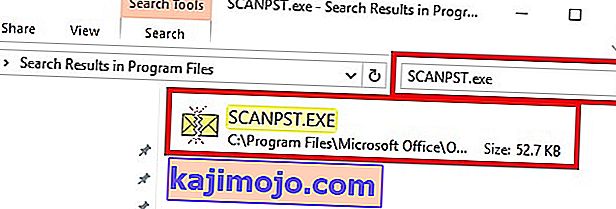 Note: If you don’t manage to find the SCANPST executable via the search bar, you need to navigate to the exact location. Here’s a list of the exact locations based on various Outlook versions:
Note: If you don’t manage to find the SCANPST executable via the search bar, you need to navigate to the exact location. Here’s a list of the exact locations based on various Outlook versions:2016: C:\Program Files (x86)\Microsoft Office\root\Office16 2013: C:\Program Files (x86)\Microsoft Office\Office15 2010: C:\Program Files (x86)\Microsoft Office\Office14 2007: C:\Program Files (x86)\Microsoft Office\Office12
- Open SCANPST.exe and set the path of the PST file you want to scan by using the Browse button. By default, the PST files are stored in Documents\Outlook Files. When you are ready, hit Start to begin the scan.
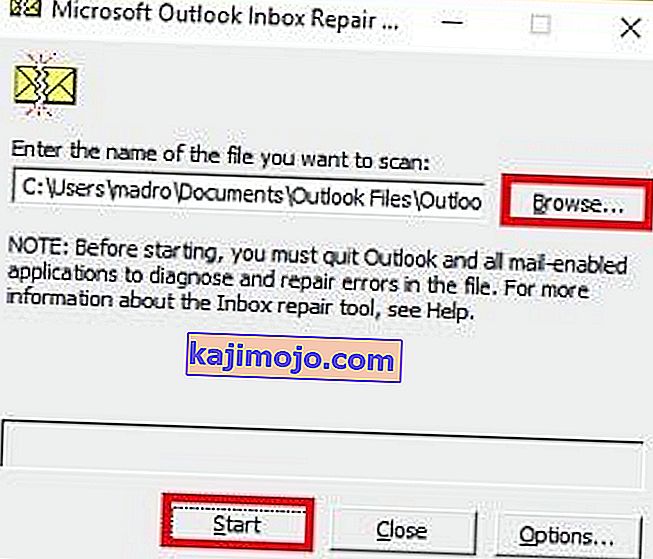
- If the scan uncovers errors or inconsistencies, click on the Repair button to fix them.
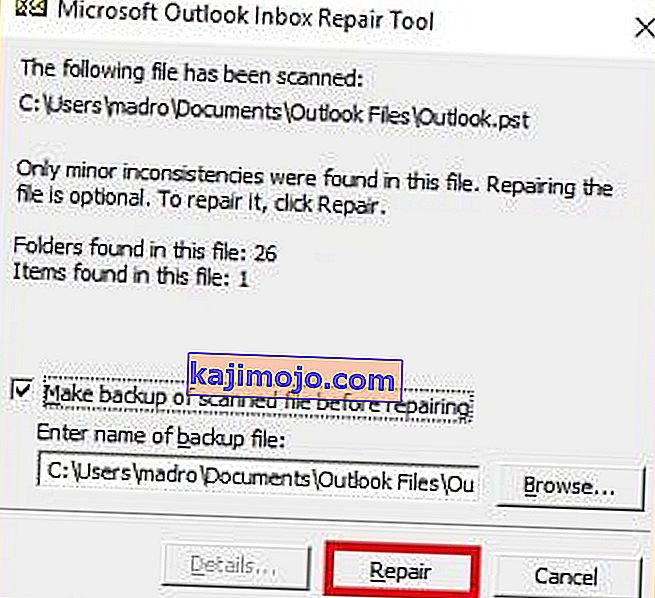
- Once the repair is done, restart Outlook with the profile that you’ve just repaired of errors and see if it starts in normal mode.
Method 7: Running the /resetnavpane command (All Outlook versions)
The navigation pane is that left portion of Outlook where you can oversee your folder list and access various icons to move between calendar, people, tasks, and mails. Sometimes, it can become glitched and prevent Outlook from starting in normal mode. Luckily, there is a command that removes any customizations to the navigation pane and gets rid of any glitch. Even better, this is done outside Outlook with ease. Here’s how:
- Close Outlook completely.
- Go to Start and access the Run application.
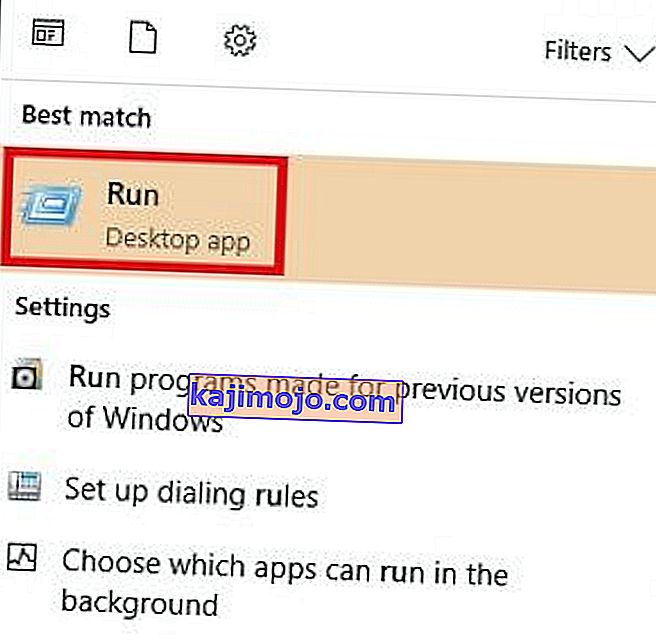
- Now, type Outlook.exe /resetnavpaneand hit OK.
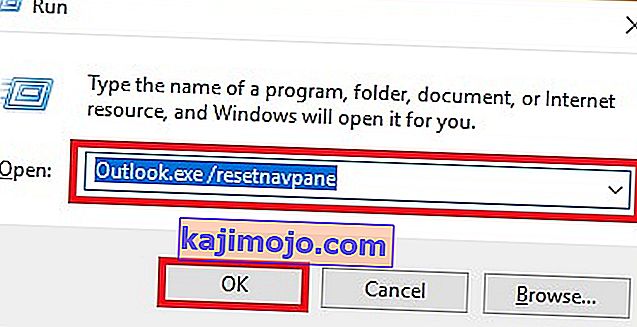 Note: Keep in mind that any customization to the navigation pane will be lost after you click on OK.
Note: Keep in mind that any customization to the navigation pane will be lost after you click on OK. - Shortly after, Outlook should automatically open in normal mode.
Method 8: Disabling compatibility mode
A lot of users have reported that they managed to start Outlook in normal mode after finding out it was running in compatibility mode. Compatibility mode is designed to help a program run as if it was running on an older operating system. As it turns out, turning off compatibility mode might just fix your Outlook Safe Mode problem. Here’s how:
- Close Outlook and navigate to the Outlook.exe on your computer. The exact path of it will differ, depending on your Outlook version. Here’s a list of the exact paths depending on your Outlook version:
2016 - C:\Program Files (x86)\Microsoft Office\root\Office16 2013 - C:\Program Files (x86)\Microsoft Office\Office 15 2010 - C:\Program Files (x86)\Microsoft Office\Office 14 2007: C:\Program Files (x86)\Microsoft Office\Office12

- Right-click on Outlook.exe and click on Properties.
- Now click on the Compatibility tab and make sure the box directly under Compatibility Mode is unchecked. Hit Apply to confirm your selection.
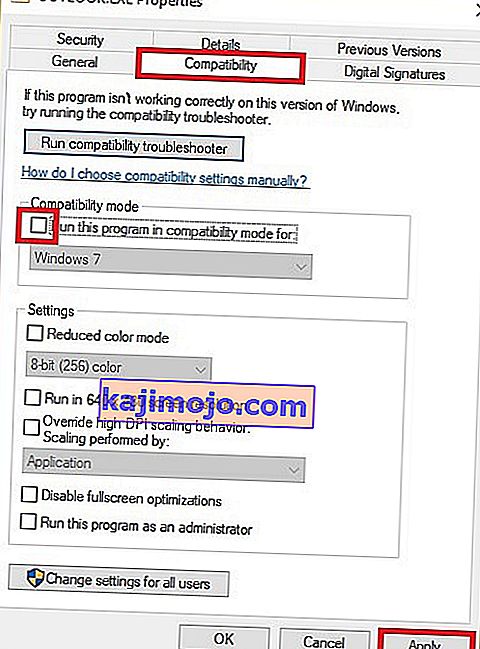
- Finally, open Outlook from the same Outlook executable and see if it manages to start in normal mode.
Method 9: Disabling hardware acceleration (All Outlook versions)
As it turns out, Outlook tries to use hardware acceleration whenever it can to make things as seamless as possible. If you’re Outlook forces itself into Safe Mode, it could very well be an issue with hardware acceleration. We can check to see if that’s the case by making some minor tweaks inside regedit. Here’s how:
- Go to Start and open the Run application.
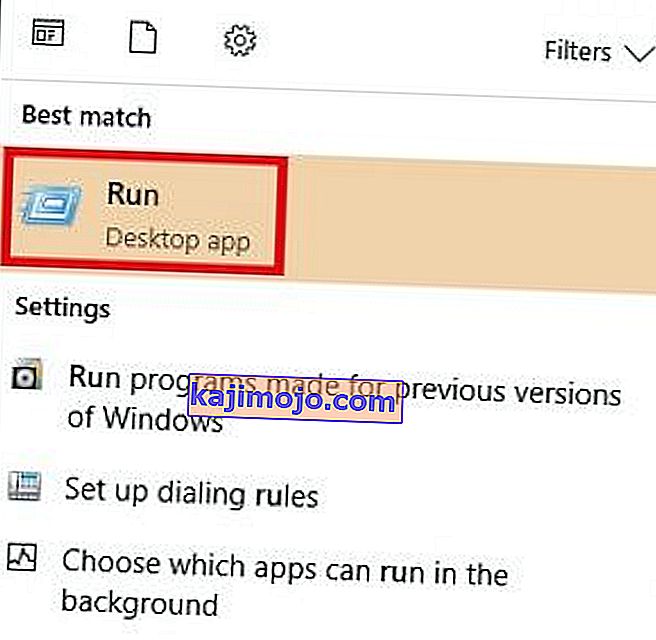
- Search for regedit and click OK to open the Registry Editor.

- Navigate your way to the following location
HKEY_CURRENT_USER\ Software\ Microsoft\ Office.
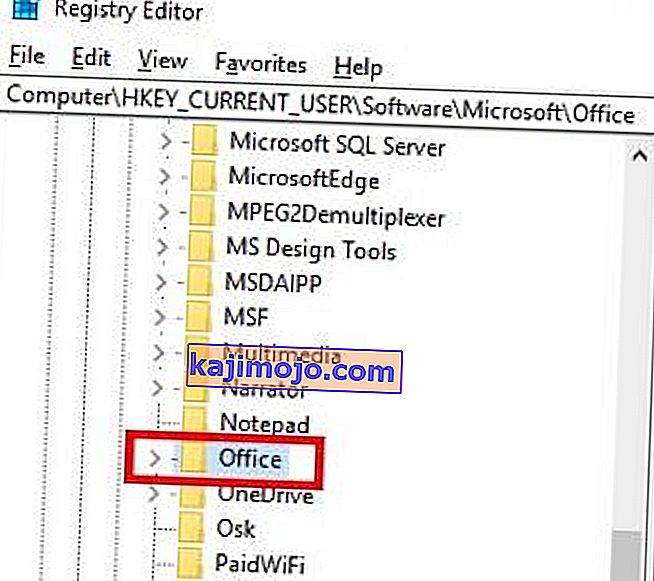
- Now, depending on which Outlook version you have, you might encounter different folders. You should either see a folder named 14.0, 16.0 or 8.0. Either way, click on the folder and double-click on the Common folder.
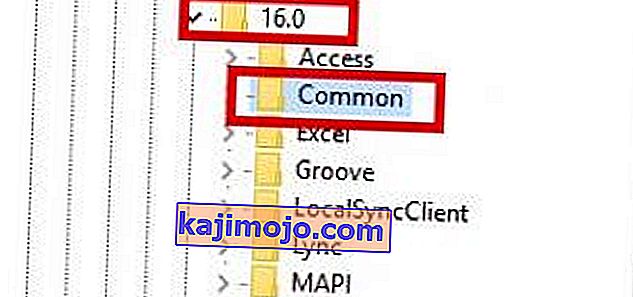
- Right-click anywhere in the Common folder, select New and click on Key and name it Graphics.
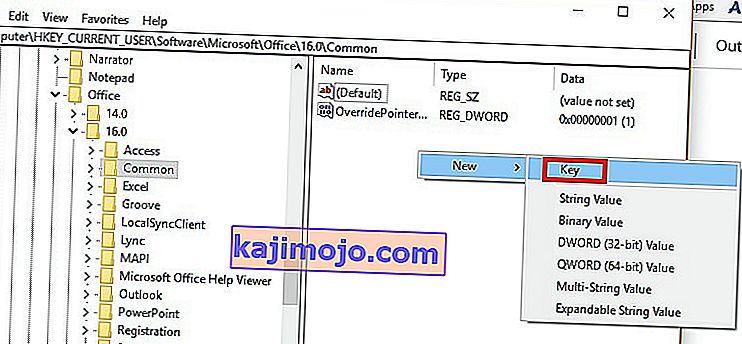
- Select the newly created Graphics folder and right-click on the right panel. From there, create a New Dword (32-bit) Value and name it DisableHardwareAcceleration.
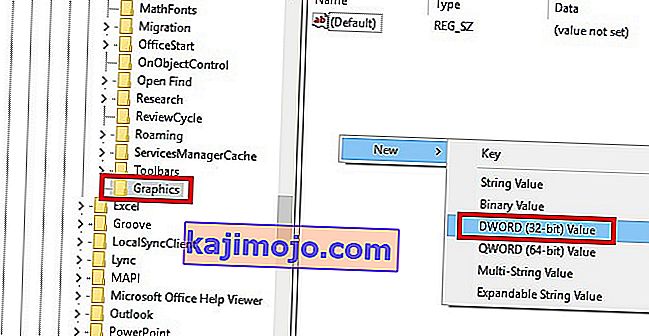
- Now double-click on DisableHardwareAcceleration and set the Value Data to 1 and hit Ok.
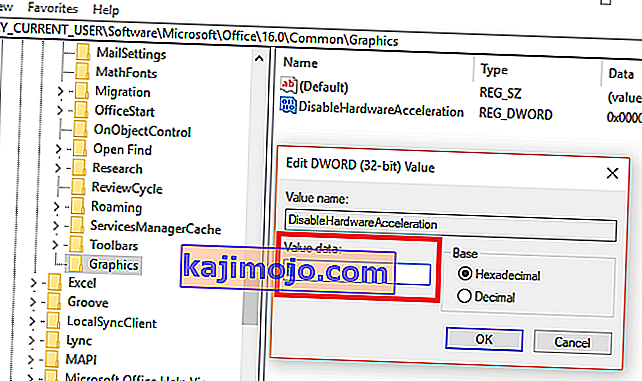
- Close regedit and open Outlook again to see if it starts in normal mode.
Method 10: Resetting the Safe Mode Registry Key (Outlook 2010)
If you have unsuccessfully followed all the methods above, there’s one more thing you can try. A final solution would be to try and prevent Safe Mode from kicking in by tweaking the registry key. But keep in mind that after you’ll follow the steps below, you won’t be able to use Safe mode in the future. At least not until you remove the key that we will create. Here’s what you need to do:
- Go to Start and open the Run application.

- Search for regedit and click OK.

- Navigate your way through HKEY_CURRENT_USER\ Software\ Microsoft\ Office.

- Now, depending on which Outlook version you have, you might encounter different folders. You should either see a folder named 14.0, 16.0 or 8.0. Either way, click on the folder navigate further to Outlook \ Security.
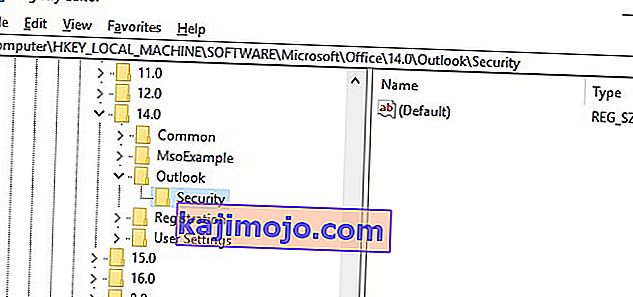 Note: If the Security folder is missing, Right-click > New > Key and type Security.
Note: If the Security folder is missing, Right-click > New > Key and type Security. - Right-click on the Security key and choose New > then DWORD (32-bit) Value.
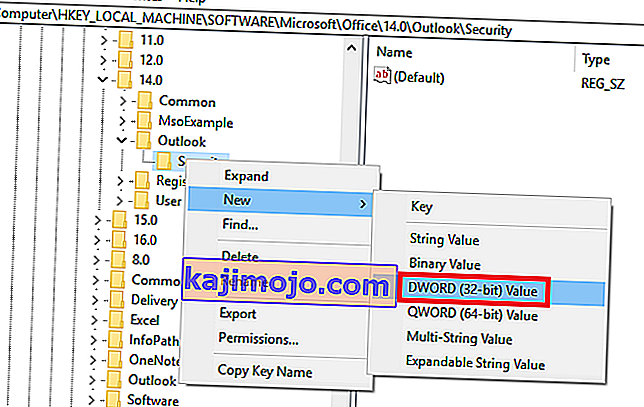
- Name it DisableSafeMode and press Enter to confirm.
- Right-click on DisableSafeMode and click on Modify.
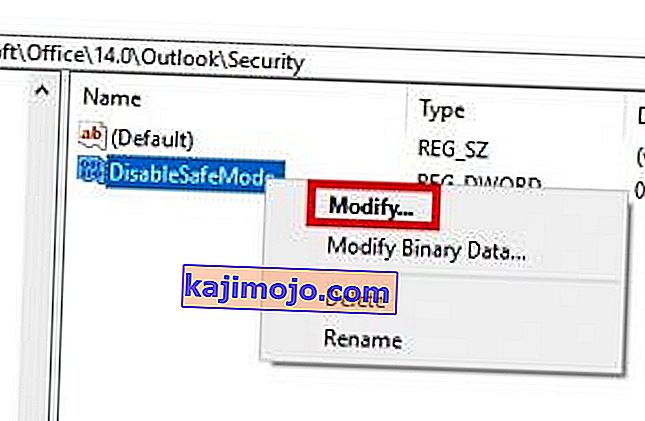
- Εισαγάγετε την τιμή 1 στο πλαίσιο Δεδομένα τιμής και κάντε κλικ στο OK .

- Κλείστε τον Επεξεργαστή Μητρώου και επανεκκινήστε τον υπολογιστή σας.
- Ανοίξτε το Outlook και δείτε εάν ξεκινά σε κανονική λειτουργία.






 Σημείωση: Μην πατήσετε Αφαίρεση ακόμα. Πρώτα πρέπει να επιβεβαιώσουμε ότι προκαλούν το πρόβλημα.
Σημείωση: Μην πατήσετε Αφαίρεση ακόμα. Πρώτα πρέπει να επιβεβαιώσουμε ότι προκαλούν το πρόβλημα.




 Note: Make sure the non-working Outlook that previously opened in Safe Mode is closed because we are now running one of the copies saved in the previous versions. Do the same for all versions listed there. Open/Close until you see the one that opens without Safe Mode. If it does work, then keep the Window open.
Note: Make sure the non-working Outlook that previously opened in Safe Mode is closed because we are now running one of the copies saved in the previous versions. Do the same for all versions listed there. Open/Close until you see the one that opens without Safe Mode. If it does work, then keep the Window open.












 Note: If you don’t manage to find the SCANPST executable via the search bar, you need to navigate to the exact location. Here’s a list of the exact locations based on various Outlook versions:
Note: If you don’t manage to find the SCANPST executable via the search bar, you need to navigate to the exact location. Here’s a list of the exact locations based on various Outlook versions:


 Note: Keep in mind that any customization to the navigation pane will be lost after you click on OK.
Note: Keep in mind that any customization to the navigation pane will be lost after you click on OK.








 Note: If the Security folder is missing, Right-click > New > Key and type Security.
Note: If the Security folder is missing, Right-click > New > Key and type Security.

